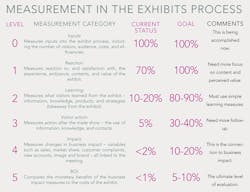Boot Camp
The Types of Data for Exhibit Evaluation
By Jack J. Phillips, PhD
As a starting point, it is helpful to view the success of the exhibit from different measurement levels. The comment "Let's move to the next level" works quite well in evaluating a trade show exhibit. Moving through six different levels generates seven types of data, as the figure on the opposite page illustrates. The first level will be measuring inputs and the highest level measures ROI.
At the first level, inputs, the input is the number of people who visited the booth along with the cost per visit. It is important to track volume, cost, and efficiencies. The next level, reaction, is very simple. It is how the visitors are reacting to the booth. This is important because initial reaction often determines the extent of additional involvement in the exhibit. At level two, the measures focus on the actual takeaways, the message they are receiving, and the information that they are acquiring. This is important because if they are not getting the message, there will be no follow-up on their part.
Level three is the actual follow up, monitoring what booth visitors do when they leave the exhibit. (Are they contacting a satisfied customer, reviewing ratings, using a coupon?) Level four is the impact, the critical measure for the executives, showing the improvement in sales, market share, new customers, and other important measures. These measures often reflect the reason we are exhibiting. Finally, there is the financial ROI, where the monetary value of the impact of the exhibit is compared to the cost of the exhibit. This is the ultimate level of evaluation. In addition, some impact measures are not converted to money, and these are the intangibles. An intangible is defined as a measure that is not converted to money (it cannot be converted credibly with a reasonable amount of resources). These measures will be fully explored in other columns.
Setting Objectives
A fundamental step in this methodology is setting objectives. Clearly defined objectives provide the focus and direction for the entire exhibit team. Objectives should be developed for each of the levels of evaluation shown in Figure 1. Objectives should be set at the reaction level and define several specific reactions desired from the booth visitors. Learning objectives define the message that you want to deliver – the information takeaways from the exhibit. Application objectives define the action you want the booth visitors to take after they leave the exhibit. Impact objectives are consequences of their actions, which, for the most part, would be actual sales, market shares increase, customer satisfaction, etc. The ROI objective is the ratio of the money returned to the investment in the exhibit, as defined earlier.
The next column will focus on the measures at the exhibit, which include the first three levels. These are important because it allows you to make adjustments and these are the early indicators of success.
Jack J. Phillips, PhD is a world-renowned expert on accountability, measurement, and evaluation. Phillips provides consulting services for Fortune 500 companies and major global organizations. The author and editor of more than 50 books, he conducts workshops and presents at conferences throughout the world. His expertise in measurement and evaluation is based on more than 27 years of corporate experience in the aerospace, textile, metals, construction metals, and banking industries. He is chairman of the ROI Institute, Inc., and can be reachd at 205.678.8181 or by email at [email protected].


